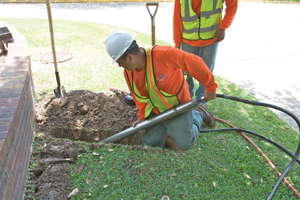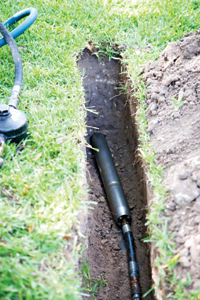Piercing Tools Make the Difference for Cable Contractor
July 1, 2008
 American Communications Construction understands the importance of leaving a small footprint. The Houston-based company installs more than 10,000 ft of distribution and trunk cables for Comcast every week in residential areas throughout Houston.
American Communications Construction understands the importance of leaving a small footprint. The Houston-based company installs more than 10,000 ft of distribution and trunk cables for Comcast every week in residential areas throughout Houston.“These homeowners have spent a considerable amount of money to landscape their yards, and our job is to install the cable while minimizing disruption to their landscapes,” says Aven McBride, president of American Communications Construction.
McBride founded American Communications Construction in 2001 in order to have his own say in how the company was structured and operated. He previously spent more than 20 years in the cable television industry. Today, American Communications Construction specializes in fiber-optic placement, cable splicing and fiber-optic and cable testing. The company also helps customers to design new plant infrastructures.
American Communication Construction works for a number of cable providers in the Houston area, including Comcast. McBride’s company is responsible for the repair of distribution and truck cable lines that have gone bad or have been damaged by contractors. The Houston area uses a rear easement in the residential areas to place all utility lines, which means that these lines are basically in the backyards of homes throughout the city.
“If we went into these easements with a trencher and opened a trench from fence to fence in the backyards, obviously we would cut a number of service drops or service cables and destroy the homeowners’ landscaping, which would create some issues,” says McBride.
When McBride started his company, he decided to use HammerHead piercing tools to replace the cable lines.
“Basically, using piercing tools is the norm for us because it minimizes our restoration costs and the impact on the homeowner’s property,” says McBride. “Instead of cutting a 50-ft long trench, we only excavate two small pits no more than 10 in. wide by 30 in. long. You can hardly tell we were even there.”
Jack Parker oversees operations for the company and likes the piercing tools because they’re fast. “Production is the key in our business,” he says. “We have six crews in the field and each crew carries two piercing tools. They are required to install 300 ft of cable per day, so we need a fast and user-friendly piercing tool.”
According to Parker, once a work order is received from Comcast, American Communications Construction contacts one-call to locate the existing utilities at the property. This can also be the biggest challenge for his crews.
“The one-call locators in the Houston area are inundated,” says Parker. “It’s difficult to have the utilities located before our crew arrives at a property. We’re one of the few contractors that communicate with the one-call locators every day, such as by E-mailing or faxing them a list of our crew’s locations, because the priority of our work orders changes daily.”
Despite all of the changes, homeowners receive notification that work will be completed 24 to 48 hours in advance. American Communication Construction crews leave a door hanger at each affected residence, letting them know why and when work is being done. This gives the homeowner time to move pets out of their yard or unlock gates. Parker notes that there are work orders from Comcast that are rush jobs that require a line to be replaced right away. These cases require enhanced communication with one-call and the homeowners.
Since most of the yards American Communications Construction works in are landscaped, the crews take extra care to minimize damage to the lawn and landscape and HammerHead piercing tools are ideal for this purpose, the contractor says.
“First, there’s minimum restoration when we use the piercing tools, but since the yards are landscaped we try and pick and choose where we dig our entry and exit pits,” says Parker. “Obviously, we’re not going to dig a pit right under a flower bed, if we can help it. We’ll move the line if needed to avoid landscapes.”
The crew will hand-dig the pits, which are 30 in. deep and 10 in. wide on average, to maintain the minimum 24 in. of cover required in the Houston area. The ground conditions consist mainly of clay and sandy clay soils. Sod is removed and placed out of the way. In some cases, the crew will even place the dirt from the pits on plastic to protect the lawn. Once the entry and exit pits are completed, the crew positions a 3-in. HammerHead piercing tool and begins the piercing process.
 Most shots range from 40 to 50 ft. Some have been as long as 150 ft, depending on the layout of the homeowner’s yard. Once the bore is complete, American Communications Construction pulls through the cable-in-conduit, which is provided by Comcast. The cable-in-conduit helps minimizes future cut cables since the cable is encased in a PVC conduit. A 1.25-in. conduit is used for distribution and fiber-optic cable, while trunk lines are carried in a 1.5-in. conduit. Once the cable-in-conduit is in place, the crews make all necessary connections and test the line. Then the crew backfill the pits, use an air tamper to compact the soil back into each pit to minimize any potential sink holes and put the sod back into place.
Most shots range from 40 to 50 ft. Some have been as long as 150 ft, depending on the layout of the homeowner’s yard. Once the bore is complete, American Communications Construction pulls through the cable-in-conduit, which is provided by Comcast. The cable-in-conduit helps minimizes future cut cables since the cable is encased in a PVC conduit. A 1.25-in. conduit is used for distribution and fiber-optic cable, while trunk lines are carried in a 1.5-in. conduit. Once the cable-in-conduit is in place, the crews make all necessary connections and test the line. Then the crew backfill the pits, use an air tamper to compact the soil back into each pit to minimize any potential sink holes and put the sod back into place.“We try and get everything back the way it was and most of the time you can’t even tell we were there,” says Parker. “The entire process takes about two to three hours per residence to install up to 150 ft of cable. The piercing tools really enhance our efficiency.”
American Communications Construction has been using the new Catamount piercing tools from HammerHead, and according to Parker, these tools are helping to make their crews more efficient.
“The Catamount works faster than the standard active heads we were using,” says Parker. “The best thing we like is that the Catamount starts easier and faster in the soft and sandy ground conditions in our area. With active heads, we had to lower the air pressure in sandy conditions.”
According to Will LeBlanc, senior regional sales manager for HammerHead, the new tool design brings to the industry a reciprocating head that is easy to start, regardless of air pressure level, and is the first pneumatic piercing tool head that is effective in both hard conditions and soft soils and sand.
“The Catamount design eliminates the need for a mechanical spring, which is prone to fail over time,” says LeBlanc. “It’s completely different than any other tool design in the market, as we’ve taken technology from downhole hammers and incorporated them into a this tool.”
Looking back, McBride is amazed at how fast his company has grown in only seven years. He’s also glad he made the decision to use piercing tools.
“From our perspective, there’s no better way to install short-run cable lines,” say McBride. “It’s been a key to our business success and has set us apart from the competition. I can’t imagine using anything else.”
Greg Ehm is a features writer, based in Des Moines, Iowa.
